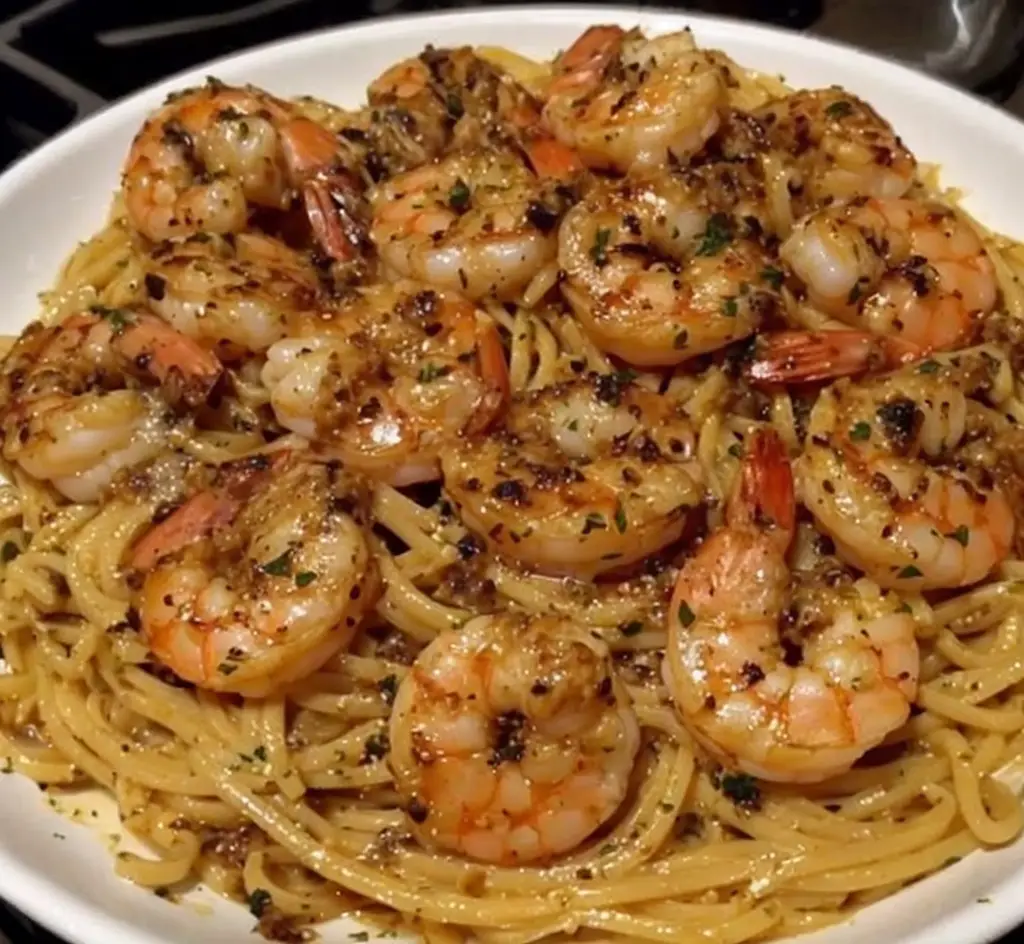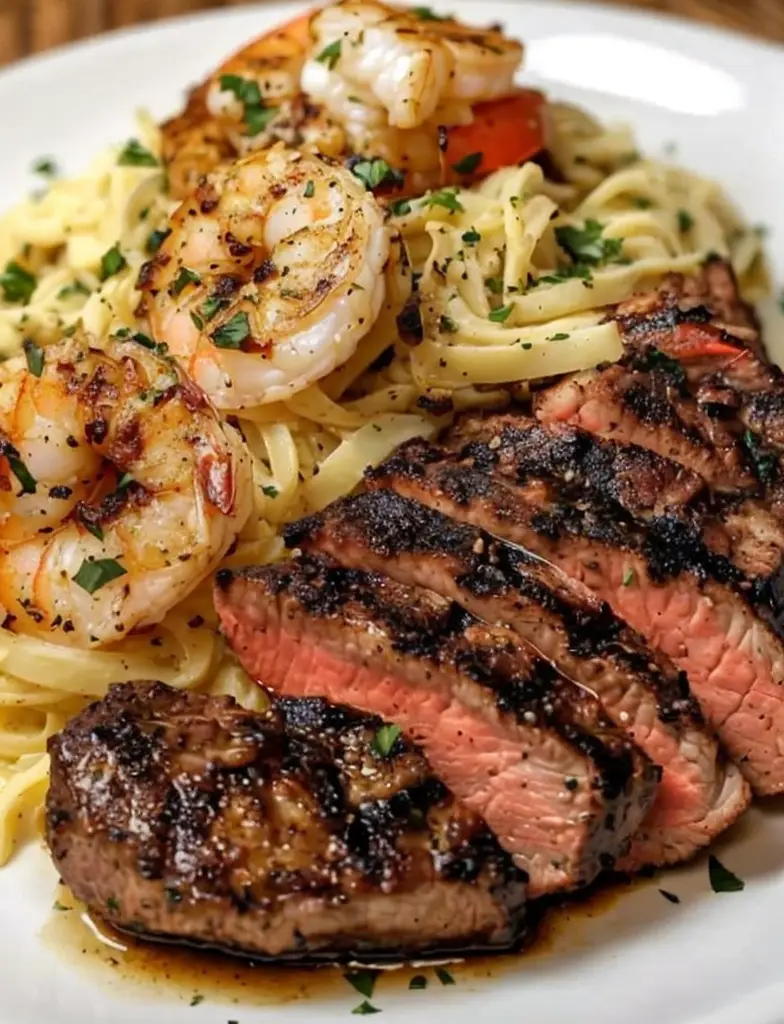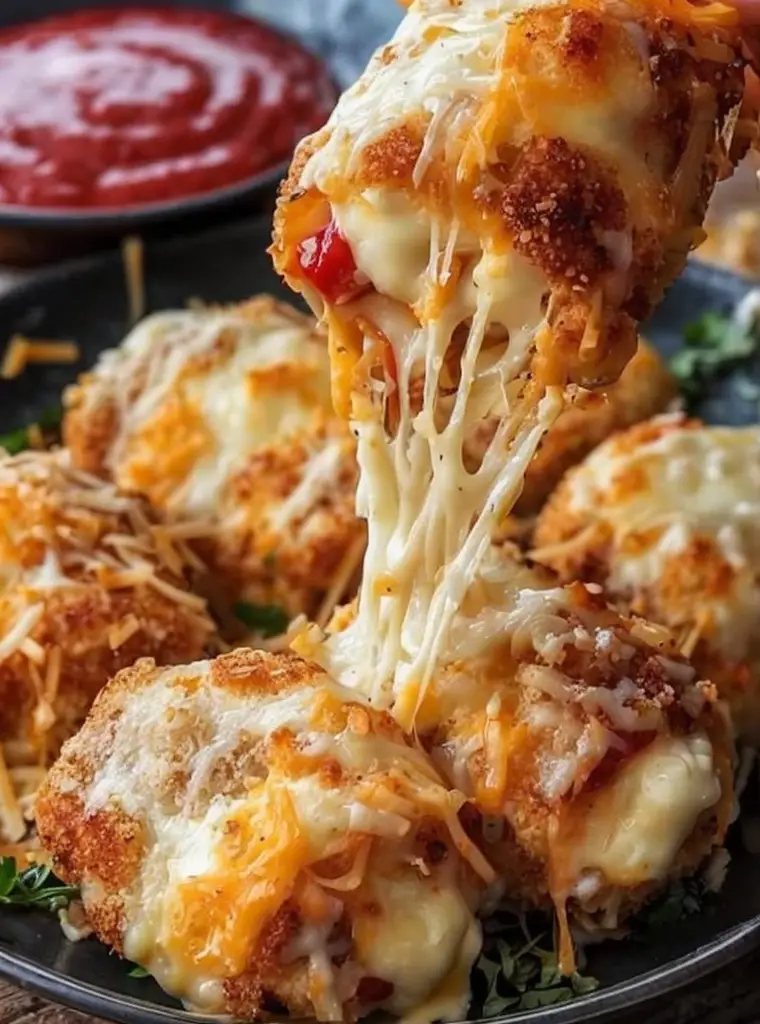Garlic Shrimp Pasta: A Delightful Seafood Dinner
Savor the rich and irresistible flavors of Garlic Shrimp Pasta, a seafood dish that brings the charm of the ocean right to your dining table. This dish is a delightful blend of juicy shrimp encapsulated in a flavorful garlic butter sauce that embraces al dente pasta strands. Whether you’re whipping up dinner for a special occasion or a weekday meal, this recipe provides a quick and flavor-packed solution that’s sure to impress.
This Garlic Shrimp Pasta recipe captures the very essence of Mediterranean cuisine while being incredibly easy to prepare, ensuring you spend less time cooking and more time enjoying this delightful dish. The succulent shrimps are perfectly seasoned and cooked to tender perfection, harmoniously blending with the aromatic garlic and savory butter sauce.
Quick Recipe Highlights
- Flavor Profile: This dish is a symphony of savory garlic and butter notes, perfectly complemented by the delicate sweetness of fresh shrimp.
- Texture: Expect a delightful contrast between the tender pasta and the succulent bite of juicy shrimp, making each bite a textural delight.
- Aroma: The robust aroma of garlic infuses the kitchen, creating an inviting atmosphere that heralds a flavorful meal.
- Visual Appeal: A vibrant mix of plump shrimp and pasta garnished with fresh parsley adds a burst of color and aesthetic appeal.
- Skill Level Needed: Ideal for kitchen novices and seasoned chefs alike, this recipe relies on straightforward techniques and quick cooking times.
- Special Equipment: A large skillet and a pasta pot are essential to bring this dish together seamlessly.
Recipe Overview
- Difficulty Level: Rated as easy, this recipe is perfect for cooks of all levels, using simple ingredients and straightforward steps that require no formal culinary training.
- Category: Perfect for dinner or a luxurious lunch, this pasta dish is versatile enough to fit any dining occasion.
- Cuisine: Inspired by Italian and Mediterranean traditions, this dish brings a taste of coastal Europe to your home.
- Cost: Generally affordable, this recipe leverages pantry staples along with seafood for a restaurant-quality meal without breaking the bank.
- Season: Though delightful year-round, this recipe shines in the warmer months, celebrating fresh shrimp and aromatic herbs.
- Occasion: Perfect for intimate dinners, family gatherings, or when you want to impress guests without extensive effort.
Why You’ll Love This Recipe
Garlic Shrimp Pasta stands out for its remarkable flavor profile, mingling sharp garlic with sweet shrimp and creamy butter in a harmonious balance. It boasts a simple preparation process that fits busy lifestyles, allowing you to create an impressive meal with minimal effort. Nutritionally, shrimp offers lean protein and essential nutrients, making this dish both delicious and health-conscious. It’s perfect for entertaining, bringing a sophisticated touch to dinner parties or casual gatherings, ensuring every guest is satisfied. With its cost-effectiveness, you can enjoy gourmet dining at home without a hefty price tag, utilizing readily available ingredients.
Historical Background and Cultural Significance
Originating from the rich culinary past of coastal regions, Garlic Shrimp Pasta draws inspiration from both Italian and Mediterranean cultures, where seafood and pasta combine in various traditional recipes. Over time, this dish has evolved, embracing influences from diverse gastronomic traditions, each adding unique flavors and techniques. Its cultural importance lies in its ability to adapt and resonate across different culinary landscapes, symbolizing the fusion of the sea’s bounty with earthy garlic notes cherished worldwide. Regional variations highlight local ingredients and cooking styles, offering endless possibilities and interpretations.
Ingredient Deep Dive
Shrimp takes center stage in this recipe, revered globally for its delicate flavor and versatile nature. Historically tied to both luxury and sustenance, shrimp has navigated culinary traditions since antiquity. Nutritionally, they deliver valuable protein, omega-3 fatty acids, and essential minerals while remaining low in calories and fat. Opt for sustainably sourced shrimp for both ecological and health benefits. Store shrimp properly in the coldest part of your fridge and consume them within two days of purchase, though freezing extends their shelf life. When substitution is necessary, scallops or firm white fish can provide alternatives, keeping the dish vibrant and satisfying.
Common Mistakes to Avoid
- Overcooking Shrimp: Shrimp cook quickly; remove them from heat as soon as they turn opaque to keep them juicy and tender.
- Improperly Salted Pasta Water: Ensure the pasta water is well-salted for an adequately seasoned final dish.
- Using Low-quality Pasta: Choose high-quality pasta to maintain texture and flavor integrity after cooking.
- Lack of Garlic Flavor: Don’t skimp on garlic; it defines the sauce’s bold taste.
- Cold Ingredients: Bring all ingredients to room temperature before starting to ensure even cooking.
- Skipping Pasta Water: Reserve a bit of pasta water to adjust sauce consistency if needed.
- Ignoring Shrimp Size: Adjust cooking time according to the size of the shrimp; smaller shrimp require less time.
- Inadequate Sauce Coating: Toss pasta thoroughly in the sauce to maximize flavor absorption.
- Wrong Skillet Size: Use a skillet large enough to hold all ingredients without overcrowding, ensuring even cooking.
- Omitting the Sear: Searing shrimp quickly in hot oil enhances flavor through caramelization.
Essential Techniques
Mastering the perfect pasta cook is crucial; aim for al dente texture by checking a minute or two before the package instructions. Understanding the sauté process ensures the garlic doesn’t burn, releasing its aroma and flavor without bitterness. Searing involves cooking shrimp in a hot pan until just opaque, capturing natural sweetness while maintaining tenderness. Combine pasta and sauce off the heat to let flavors meld without fear of overheating. Visual cues like vibrant shrimp color and lightly golden garlic indicate successful execution of techniques pivotal to the dish.
Pro Tips for Perfect Garlic Shrimp Pasta
- Choose large shrimp for maximum flavor impact and an impressive presentation, cooking until just opaque for tenderness.
- Infuse oil with garlic slowly over medium heat to create a deep, aromatic base for the sauce.
- Use fresh parsley as a garnish to add a pop of color and brightness that complements the savory dish.
- Experiment with lemon zest for an added citrusy note that enhances other flavors and adds freshness.
- Boost your beurre blanc: A small amount of white wine can elevate the sauce, adding complexity and depth.
- Get creative with pasta shapes; while linguine or fettuccine offer tradition, a penne or fusilli can provide a fun twist.
- Incorporate red pepper flakes for heat, adjusting quantity based on spice preference for added complexity.
- Mix in a touch of cream for additional richness, balancing the garlic’s boldness with buttery smoothness.
Variations and Adaptations
Explore regional flavors by adding Italian influences with sun-dried tomatoes or a Mediterranean twist with capers and olives. Adapt the dish for different seasons by incorporating seasonal squash or artichoke hearts in spring and summer. For dietary needs, gluten-free pasta or zucchini noodles make excellent swaps without sacrificing taste. Flavor-wise, include unique spices such as smoked paprika or cumin for a surprising departure. Texture adaptations might involve incorporating crushed nuts or breadcrumbs on top for a delightful contrast. Presentation can embrace family-style serving in large dishes or individual twirls for refined dining experiences.
Serving and Presentation Guide
For a refined presentation, consider twirling pasta neatly onto plates and topping with a few shrimp, plus a sprinkle of fresh herbs. A visual touch of lemon wedges adds color and zesty potential. Serve traditionally with a simple green salad or a modern twist using roasted vegetables. Adjust serving temperature to warm, allowing ample time for full flavor expression without compromising shrimp tenderness. Efficient portion control ensures each diner enjoys a balanced allotment of shrimp and pasta, catering to both light eaters and hearty appetites.
Wine and Beverage Pairing
Pair Garlic Shrimp Pasta with a crisp white wine such as Sauvignon Blanc or Pinot Grigio, whose acidity complements the richness of garlic and shrimp. Consider non-alcoholic options like sparkling water with a hint of lemon for refreshment that echoes citrus notes. When serving coffee or tea, choose lighter blends such as a delicate white or green tea, which won’t overpower the dish. Beverage temperature should align with room temperature pasta, creating a cohesive dining experience. Equip diners with suitable glassware to highlight each drink’s aroma and flavor, enhancing the meal’s elegance.
Storage and Shelf Life
Store leftover Garlic Shrimp Pasta in an airtight container in the refrigerator, consuming it within two days to maintain optimal taste and texture. Keep it cold until reheating, recommended gently on the stove over low heat with added pasta water or stock for moisture. Assess spoilage through smell and appearance, discarding if there are off-putting changes. For freezing, separate components and thaw in the refrigerator before reuniting over gentle heat, preserving flavor integrity. Portion leftovers accordingly for easy reheating, even on the busiest of days.
Make Ahead Strategies
Prepare elements in stages to simplify future assembly: cook pasta in advance and toss it with a bit of olive oil to prevent sticking. Store it separately from the sauce, combining right before serving. Shrimp can be pre-seasoned to save time, maximizing flavor absorption. Batch prepare sauce and freeze it in portions for quick meals. For a complete dish, reheat gently with a splash of stock to keep the sauce luscious and pasta hydrated, retaining freshness through skilful last-minute touches.
Scaling Instructions
For a smaller batch, halve ingredient quantities with attention to oil and sauce components to maintain balance. Doubling or tripling requires a larger skillet and attention to crowded shrimp, perhaps cooking in batches to preserve quality. Adjusting for more time typically involves monitoring heat levels closely, ensuring no ingredient overcooks. With larger quantities, reheating properly in batches ensures even temperature and flavor distribution. Store properly scaled portions in meal-prep containers for convenient leftovers that mirror their freshly-cooked counterparts.
Nutritional Deep Dive
Each serving of Garlic Shrimp Pasta provides a harmonious blend of proteins, fats, and carbohydrates. Shrimp supplies lean protein, vital for muscle repair and satiety, alongside healthy omega-3 fatty acids supporting cardiac health. For micronutrients, enjoy the benefits of garlic’s anti-inflammatory properties and parsley’s vitamin C. Pay attention to serving sizes when managing caloric intake, enjoying balanced components while keeping dietary goals in mind. Consider integrating fiber-rich side dishes to complete a wholesome meal without calorie overload.
Dietary Adaptations
Craft a gluten-free version effortlessly by substituting pasta with gluten-free alternatives, maintaining consistency and taste. Dairy-free transformations are seamless by using olive oil or vegan butter in lieu of traditional butter. For vegan variations, add roasted tofu or mushrooms instead of shrimp, providing comparable texture and savoriness. Low-carb adherents might opt for spiralized vegetable noodles, seamlessly blending flavor with health considerations. Paleo adjustments revolve around natural ingredients, focusing on sustainably sourced shrimp and fresh vegetables for a clean eating experience.
Troubleshooting Guide
Address texture concerns by checking shrimp’s doneness before removing from heat to avoid rubberiness. Achieve flavor balance by tasting the sauce prior to serving, adjusting salt or lemon juice to taste. Temperature discrepancies can be minimized by reheating over moderate heat, preventing component drying. Equipment limitations might be overcome by dividing tasks, such as using multiple burners or making do with available pan sizes. Ingredient substitutions should focus on preserving core flavors, such as using white fish when shrimp isn’t available. Time management is key; prepare ingredients in advance to adhere to suggested cooking times seamlessly.
Recipe Success Stories
Countless readers have delighted in the simplicity and elegance of Garlic Shrimp Pasta, sharing photos of the vibrant dish garnished impeccably. Creative adaptations have emerged, from including local spices to pairing with regional wines, inspiring a community of cooks. Feedback highlights appreciation for easy instructions, enabling families to bond over a sumptuous meal. Photography tips recommend capturing the steaming pasta with fresh garnish, inviting followers to join in the feast visually. Every shared success increases the collective expertise, each rendition a testament to the recipe’s charm.
Frequently Asked Questions
Yes, but ensure they are thoroughly thawed and patted dry before cooking to prevent waterlogged shrimp.
2. Is it possible to use another type of pasta?
Absolutely, any pasta that holds sauce well will work, though shapes like linguine or fettuccine are traditional.
3. What if I want a spicier dish?
Adding red pepper flakes or a dash of chili oil into the sauce introduces more heat without altering the core profile.
4. How can I store leftovers effectively?
Store in airtight containers, separating pasta and sauce if possible, to prevent sogginess and ensure reheated quality.
5. Is pre-cooked shrimp suitable?
While you can use pre-cooked shrimp, fresh raw shrimp provide a superior texture and depth of flavor when prepared fresh.
6. What’s a good non-alcoholic pairing?
A citrus-infused sparkling water complements the dish’s flavors well, adding lightness with its refreshing notes.
7. Can I add vegetables to the dish?
Easily incorporate vegetables such as spinach or cherry tomatoes for added color and nutrients, sautéing briefly in the sauce.
8. What if my garlic burns?
Restart the garlic stage, using a gentler heat, to avoid bitter flavors detracting from the overall experience.
9. How should I adjust for salt content?
Taste the sauce and adjust the salt at the end as needed, especially if using salted butter or pre-salted components.
10. Can I make this dish ahead of time for a party?
Assemble ingredients ahead and quickly toss fresh pasta and shrimp in sauce just before serving for optimal taste and presentation.
11. What is the best way to reheat pasta without drying it out?
Add a splash of reserved pasta water or broth while gently reheating on the stove to rejuvenate the sauce’s texture.
12. Can I freeze this recipe?
While fresh is best, freezing components separately, such as the cooked shrimp and garlic sauce, allows for a reliable make-ahead solution.
Additional Resources
Explore a range of pasta recipes to diversify your cooking arsenal, including creamy fettuccine and rustic spaghetti dishes. Techniques for perfecting homemade pasta and garlic infusion offer skills enhancement, while insights into shrimp sustainability guide environmentally-friendly choices. Learn about key garlic varieties emphasizing flavor profiles, complementing a repertoire eager for exploration of its pungent pleasures. Equipment reviews reveal ideal kitchen tools optimizing efficiency and ease during preparation. Seasonal guides highlight ingredient swaps aligning with nature’s rhythms, ensuring fresh, flavorful progressions in your culinary journey.
Join the Conversation
Connect with fellow cooking enthusiasts by sharing your culinary twists and photos of Garlic Shrimp Pasta on social media. Exchange photography tips for capturing the most mouthwatering shots of your dish. Discuss variations that resonate personally and why, adding to the communal pool of ideas. Write recipe reviews, diving deep into the aspects you cherished most, from taste to ease of preparation. Engage in community forums where this recipe sparks creativity, unveiling fresh takes and memorable shared dining experiences.
The Recipe
Garlic Shrimp Pasta
Serves: 4
Prep Time: 15 mins
Cook Time: 15 mins
Total Time: 30 mins
Kitchen Equipment Needed
- Large Skillet
- Pasta Pot
- Colander
- Mixing Spoon
- Measuring Cups and Spoons
Ingredients
- 12 oz linguine pasta
- 1 lb large shrimp, peeled and deveined
- 4 tablespoons unsalted butter
- 6 cloves garlic, minced
- 1/4 teaspoon red pepper flakes
- 1 tablespoon lemon juice
- Salt and pepper to taste
- 1/4 cup chopped fresh parsley
Directions
- Cook pasta according to package instructions until al dente. Reserve 1 cup of pasta water and drain the rest.
- In a large skillet, melt butter over medium heat. Add garlic and red pepper flakes, sautéing until garlic is fragrant, about 1 minute.
- Add shrimp to the skillet, cooking until pink and opaque, about 3 minutes per side. Stir in lemon juice and season with salt and pepper.
- Toss in cooked pasta, adding reserved pasta water to loosen sauce as needed. Mix in parsley and serve warm.
Recipe Notes
- If desired, add a splash of white wine when cooking the sauce for depth of flavor.
- Substitute parsley with basil for a different herbal note.




